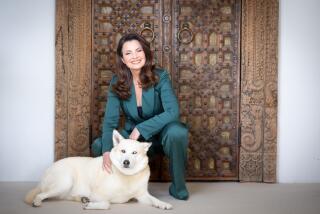A Hollywood League of Their Own
Just days before Halle Berry snagged her historic Oscar, another Hollywood barrier fell, quietly, with less fanfare, but engendering the same sense of disbelief that it had taken so long: A woman, Martha Coolidge, was named president of the Directors Guild of America.
She’s not alone at the top of the heap. In a coincidental convergence never before seen in Hollywood, women are running the town’s other major guilds as well.
In March, Coolidge joined Vicki Riskin, the first female president of the Writers Guild of America, West, and Melissa Gilbert, the third woman to serve as president of the Screen Actors Guild.
Together, they represent 12,000 directors, 8,500 writers, 98,000 actors--the majority of Hollywood’s talent pool.
“I think, in a grand scale, it clearly means that women are playing in what has traditionally been a boys’ club up to now,” said Gilbert, a former star of “Little House on the Prairie.” “It’s exciting to be a part of this, but I look forward to the day when it’s not even a qualification.”
Whether there is more to it than the curiosity factor is a matter of some debate in Hollywood, where dismal statistics persist on the treatment and hiring of female writers, directors and actors. For example, according to DGA records, female film directors are working less and less. Certainly, the guild presidents find themselves at the helm during a time of tumult and contradictions--one in which female executives, including studio heads such as Stacey Snider, Sherry Lansing and Amy Pascal, are relatively prominent and plentiful, but female talent still struggles. Moreover, the unions now must square off against negotiating opponents that are not simply studios or networks but vast multinational corporations with deep resources, conglomerates that many in the creative community already fear are attempting to erode artistic freedoms.
For many in town, the mere discussion of the gender of guild presidents brings about groans. It seems about as relevant as the onetime feminist flash point “Ally McBeal,” which is going off the air.
“We should be past it. Do you know how many trillions of times I’ve been asked, ‘As a woman, what was it like ... ?’” said Oscar-winning writer-director Callie Khouri, a WGA board member. “And my answer always is, ‘As opposed to what? Reality?’”
Yet she noted: “It’s shameful how few women and blacks are working in Hollywood.”
Traditionally, the talent guilds have been among the most influential unions in town because a strike can have serious economic consequences. “They have a bully pulpit,” Alan Brunswick, a labor lawyer, said of the guild presidents. “Any one of them can get a meeting with any of the studio heads at any time because of their position.”
Having women in such positions, said Meryl Poster, co-president of Miramax Films, “is a sign of the progress we’ve made, but there is still plenty of room for more.”
The three guild heads are not planning any collective efforts to improve diversity and have not yet met to discuss business. Coolidge described her task as to “pressure, embarrass, prepare and educate our members and the employers.”
“We can’t tell people who to hire and how to hire them, but we can certainly commend or admonish them for what they do or don’t do,” said Gilbert, whose union has been mired in internal strife for two years.
Riskin and Gilbert won their posts in open elections, while Coolidge, formerly the DGA’s first vice president, was named by the board to replace Jack Shea when he retired. All the positions are unpaid.
The three are part of a veritable bumper crop of female guild presidents in power in Hollywood today, including Kathleen Kennedy at the Producers Guild of America and Lisa Zeno Churgin at the Motion Picture Editors Guild. They join a plethora of women in the executive ranks, ranging from the three female studio chairs to the four women--Susan Lyne, Nancy Tellem, Gail Berman and Dawn Tarnofksy-Ostroff--who run the entertainment divisions at ABC, CBS, Fox and UPN. The visibility, prestige and presumable influence of these women obscure the fact that employment levels for most creative women have barely budged in the past decade.
“People tend to look at women who are so high-profile and think women must be equally represented in the workplace. We know that’s not the case,” said Martha Lauzen, professor of communications at San Diego State University, who studies the employment of women in Hollywood. “If you look at the number of women working behind the scenes, they’re dramatically underrepresented.”
In the latest DGA statistics, for the year ending April 2002, women directed nine of the 145 studio films released, accounting for 6.2% of the whole. In January, the DGA released a report on the top 40 prime-time shows of the 2000-01 TV season, showing that women directed 11% of the episodes, and none on high-profile shows like “Friends.”
Female writers are slightly better off. Still, according to Riskin, only a quarter of the WGA’s membership is female, suggesting it is difficult for women to land the first job. And in 1999-2000, about half of the guild’s female writers were employed. In a study of the top-grossing 250 films of 2000, conducted by Lauzen, women accounted for 14% of credited writers.
According to the writers guild, the percentage of women working on prime-time TV in the 2001 season increased slightly, to 28%, after years of stagnating between 22% and 24%.
And that can affect what’s on the screen. “On prime-time TV, when you have at least one woman in a position of power, not only do you get more female characters on screen, but you get a different kind of female, one that tends to be more powerful,” Lauzen said.
Actors are another matter. In 2000, women claimed 38% of the SAG roles, but they all but disappeared from the screen after 40.
The dearth of women in a business in which almost everybody pays lip service to the idea of meritocracy defies easy explanation, though one top film executive said that sexism plays a significant role: “Of course, it does. What else could it be?”
Others cited the film industry’s obsession with the young male demographic and the high-octane action-adventure pieces that have ruled Hollywood for two decades.
“These are all multinational corporations with bottom lines, and the bottom-line movies are action-driven pictures,” said Hollace Davids, president of Women in Film, Hollywood’s leading professional women’s association. “You don’t tend to see women directing ‘The Mummy’ or ‘Spider-Man.’”
Although Hollywood has increasingly recognized the power of female audiences, that hasn’t translated into more women behind the scenes. This spring has brought a glut of female-driven thrillers such as “Panic Room,” “High Crimes,” “Murder by Numbers” and the upcoming “Unfaithful,” but none was directed by a woman, and only one claims a credited female co-writer.
“There is often very little time that can be devoted to searching out candidates for various jobs,” said Kennedy, the president of the producers guild. “The speed at which decisions are made often requires people to rely on word of mouth rather than resumes ... giving the appearance of a closed-door environment.”
The issue of diversity in the entertainment business is a topic that few in the executive ranks are keen to discuss openly. Those willing to speak publicly felt confident about their track records.
“We have a disproportionately [high] statistic at this studio,” said Amy Pascal, chairman of Columbia Pictures, who has nurtured the careers of such talent as Susannah Grant, Penny Marshall and Betty Thomas. “I don’t believe that men can only do a certain kind of movie or that women can do a certain kind of movie.”
“I’m actually surprised that those percentages don’t look any better,” said Toby Emmerich, New Line’s president of production. “I don’t think that I’ve ever heard anybody say that they would favor a writer or director because of gender.”
However, he does note that certain genre considerations influence which directors are hired. “On chick flicks, like ‘The First Wives Club,’ you tend to think, ‘Let’s get a woman director.’ And I suppose there’s a kind of big testosterone action picture where you tend to hire ‘shooters,’ and the ‘shooters’ tend to be men that come from the worlds of video and commercials and tough, cool stuff. Outside of those genres, I’ve never paid attention to whether the person is a man or a woman.”
Leslie Moonves, the president of CBS Television, cited the long roster of women working in the executive ranks at the network. “The boys’ club that may have existed before is disappearing,” he said. “It’s something that clearly should have happened many years ago.”
Scott Sassa, NBC West Coast president, said the opportunities, and statistics, are better for women in TV, where there are 100 shows a year, each with 24 episodes.
“Some of the top sitcom directors for us are women. Right now you have a critical mass of women who have gone through the ranks and are ready to take the top jobs in directing and writing,” he said. “We’ve been working with the guilds on diversity, and that helps.”
Some suggested that women’s lifestyle choices might be one factor depressing their employment levels. “If you want to direct a film, that’s a year of your life that’s gone,” said writer Diane English, best known for creating TV’s “Murphy Brown.” “Society makes that a tougher choice for women than it does for men.”
The three talent guild presidents are careful to note that although women’s issues are important to them, they’re not the only ones on an agenda packed with such pressing realities as runaway production. “I’m here to serve the entire membership, not just the women,” Riskin said.
Still, there are those great new networking opportunities.
As Coolidge said, “You can now have the three presidents of the guilds bumping into each other in the ladies’ room rather than the men’s room.”
More to Read
The biggest entertainment stories
Get our big stories about Hollywood, film, television, music, arts, culture and more right in your inbox as soon as they publish.
You may occasionally receive promotional content from the Los Angeles Times.










